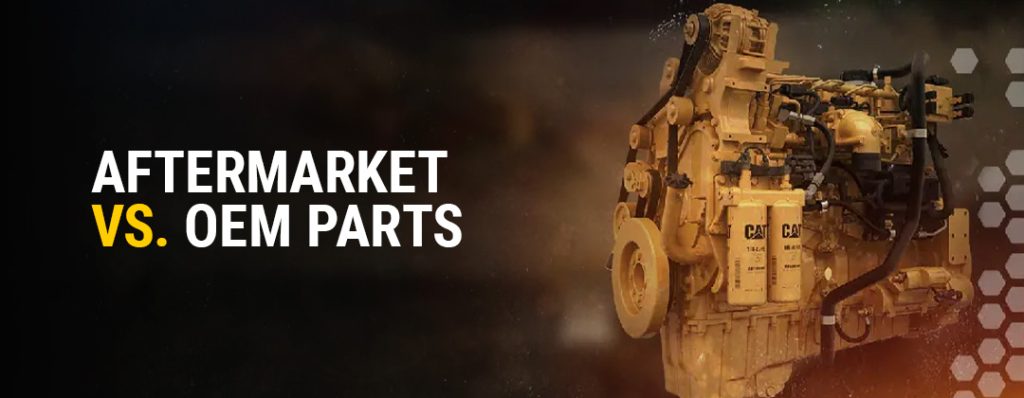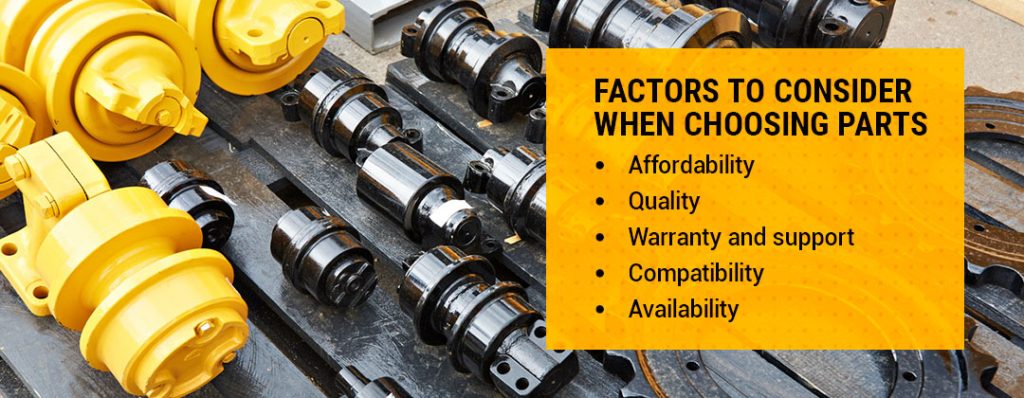
As a fleet owner, you understand the role of proper maintenance and parts selection in keeping your equipment running smoothly and maximizing its performance. When replacing components, one common dilemma is choosing between aftermarket parts and original equipment manufacturer (OEM) parts. Making the right choice ensures your equipment’s longevity, reliability and cost-effectiveness.
We aim to equip you with the knowledge needed to evaluate the quality, compatibility and overall value of aftermarket and OEM parts. We want to help you navigate the complexities of this decision-making process, ensuring that your fleet receives the best components that meet your equipment’s specific needs.
Aftermarket parts come from manufacturers other than the original equipment maker. These parts are designed to fit and function in various equipment models, offering an alternative to OEM parts. The aftermarket industry is large, providing fleet owners like yourself with an extensive range of options to maintain and repair any equipment.
One of the primary reasons aftermarket parts have gained traction is their affordability. Compared to OEM parts, aftermarket alternatives are often priced more competitively, allowing you to save significantly on upfront costs. The cost-savings of aftermarket parts can benefit large fleet owners who must maintain many vehicles or machinery.
Aftermarket parts can offer a wide selection, catering to diverse equipment models and brands. This abundance of options allows you to source parts tailored to your fleet’s needs, ensuring compatibility and efficient performance. You can choose from various manufacturers and suppliers, offering different levels of quality and specialization.
However, there can be potential drawbacks associated with aftermarket parts. Quality standards can vary among aftermarket manufacturers, leading to inconsistency in performance and longevity. While some aftermarket parts may meet OEM specifications, others fall short, compromising your equipment’s reliability and durability. Conducting thorough research and sourcing parts from reputable aftermarket suppliers is crucial to mitigate such risks.
OEM parts are components specifically designed and produced by the equipment’s original manufacturer. These parts are built to the exact specifications of the original equipment, ensuring a precise fit and compatibility. When you choose OEM parts, you get components that are exactly the same as those originally installed in your equipment.
OEM parts are known for their high quality and reliability. Since the original manufacturer makes them, you can have confidence in their performance and durability. OEM parts undergo rigorous testing to meet stringent quality standards to guarantee they meet or exceed the original equipment’s specifications.
The parts fit seamlessly with your equipment. Manufacturers have detailed knowledge of their products and engineering specifications, allowing them to create parts that integrate perfectly with the existing systems.
Choosing OEM parts often comes with the advantage of comprehensive warranty coverage. Manufacturers stand behind their products and offer warranties that protect against defects and malfunctions. Additionally, OEM manufacturers typically provide dedicated customer support, ensuring assistance and guidance throughout the warranty period.

Decide between aftermarket and OEM parts based on thoroughly evaluating your needs and circumstances. You might want to consult with experienced mechanics, industry experts or fellow fleet owners who have firsthand experience. Their insights can offer valuable perspectives and help you make an informed decision. Consider these key factors when choosing parts for your equipment, whether aftermarket or OEM.
When deciding between OEM parts and aftermarket parts for your equipment, considering each option’s advantages and concerns can help you ensure optimal performance and reliability. Consult with industry experts, authorized dealerships or mechanics with expertise in your equipment and parts. Be sure to freely share information about your equipment, usage patterns and performance expectations to receive tailored advice. Experts can help you navigate the OEM vs. aftermarket dilemma and make an informed choice aligned with your fleet’s needs and goals.
While many aftermarket parts perform adequately, OEM parts are often better in quality. OEM parts are manufactured by the original equipment maker, ensuring quality control and adherence to the equipment’s original specifications. OEM manufacturers have access to the original design specifications and can produce parts that match the exact requirements of the equipment.
When comparing prices between OEM parts and aftermarket parts, it’s common to find that OEM parts are generally more expensive. Several factors contribute to this price difference, including the following:
Deciding how to choose between OEM parts and aftermarket parts can be challenging. Remember that OEM parts are built to the original specifications, ensuring compatibility and alignment with the equipment’s systems and components. By using OEM parts, you can have confidence in their performance, reliability and long-term durability.
When sourcing genuine parts for your equipment, the Gregory Poole Equipment Company is a trusted partner you can rely on. With a commitment to quality products and responsive customer care, we have been in business since 1951.
Gregory Poole Equipment Company goes beyond providing genuine parts. We offer a range of comprehensive solutions designed to help your business thrive. From equipment sales and rental equipment to training and service for your equipment, we understand the unique needs of companies and provide tailored solutions to support your success. By partnering with us, you can access a full suite of resources to optimize equipment performance and enhance operational efficiency.
With over 70 years of experience, Gregory Poole Equipment Company has a proven dependability and reliability track record. We have built a reputation for being a trusted partner in the industry, supporting customers in various sectors and helping them stay competitive. Our company’s longevity is a testament to our commitment to customer satisfaction and our ability to adapt to changing needs and technologies.
Contact us for more information today!